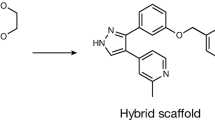Abstract
In the long history of screening for antibiotics, fungi1,2 and actinomycetes3–8,19 have been the only producers of β-lactam antibiotics although several phytopathogenic bacteria have been reported to produce toxins with a β-lactam structure9,10. We report here the first evidence that novel monocyclic β-lactam antibiotics, sulfazecin and isosulfazecin, are produced by new species of Pseudomonas.
This is a preview of subscription content, access via your institution
Access options
Subscribe to this journal
Receive 51 print issues and online access
$199.00 per year
only $3.90 per issue
Buy this article
- Purchase on Springer Link
- Instant access to full article PDF
Prices may be subject to local taxes which are calculated during checkout
Similar content being viewed by others
References
Lemke, P. A. & Brannon, D. R. in Cephalosporins and Penicillins, Chemistry and Biology (ed. Flynn, E. H.) 370–437 (Academic, New York, 1972).
Kitano, K. et al. J. Ferment. Technol. 53, 327–338 (1975).
Nagarajan, R. et al. J. Am. chem. Soc. 93, 2308–2310 (1971).
Stapley, E. O. et al. Antimicrob. Ag. Chemother. 2, 122–131 (1972).
Aoki, H. et al. J. Antibiot. 29, 492–500 (1976).
Brown, A. G. et al. J. Antibiot. 29, 668–669 (1976).
Kahan, J. S. et al. J. Antibiot. 32, 1–12 (1979).
Brown, A. G., Corbett, D. F., Eglington, A. J. & Howarth, T. T. JCS chem. Commun. 523–525 (1977).
Stewart, W. W. Nature. 229, 174–178 (1971).
Taylor, P. A., Schnoes, H. K. & Durbin, R. D. Biochim. biophys. Acta. 286, 107–117 (1972).
Kitano, K., Kintaka, K. & Nakao, Y. J. Ferment. Technol. 54, 696–704 (1976).
Doudoroff, M. & Palleroni, N. J. in Bergey's Manual of Determinative Bacteriology. 8th edn (eds Buchanan, R. E. & Gibbons, N. E.) 217–243 (Williams & Wilkins, Baltimore, 1974).
Kamiya, K. et al. (in preparation).
Nozaki, Y., Imada, A. & Yoneda, M. Antimicrob. Ag. Chemother. 15, 20–27 (1979).
Tamaki, S., Nakajima, S. & Matsuhashi, M. Proc. natn. Acad. Sci. U.S.A. 74, 5472–5476 (1977).
Spratt, B. G. Nature. 274, 713–715 (1978).
Suzuki, H., Nishimura, Y. & Hirota, Y. Proc. natn. Acad. Sci. U.S.A. 75, 664–668 (1978).
Iwaya, M. & Strominger, J. L. Proc. natn. Acad. Sci. U.S.A. 74, 2980–2984 (1977).
Scannel, J. P. et al. J. Antibiot. 28, 1–6 (1975).
Author information
Authors and Affiliations
Rights and permissions
About this article
Cite this article
Imada, A., Kitano, K., Kintaka, K. et al. Sulfazecin and isosulfazecin, novel β-lactam antibiotics of bacterial origin. Nature 289, 590–591 (1981). https://doi.org/10.1038/289590a0
Received:
Accepted:
Issue Date:
DOI: https://doi.org/10.1038/289590a0
This article is cited by
-
Wet-dry cycles protect surface-colonizing bacteria from major antibiotic classes
The ISME Journal (2022)
-
Cephalosporins as key lead generation beta-lactam antibiotics
Applied Microbiology and Biotechnology (2022)
-
Studies towards synthesis and Lewis acid catalysed functionalization of 3-(4′-substitutedphenylthio)-azetidin-2-ones
Journal of Chemical Sciences (2020)
-
Analysis of US FDA-Approved Drugs Containing Sulfur Atoms
Topics in Current Chemistry (2018)
-
Origins of the β-lactam rings in natural products
The Journal of Antibiotics (2013)
Comments
By submitting a comment you agree to abide by our Terms and Community Guidelines. If you find something abusive or that does not comply with our terms or guidelines please flag it as inappropriate.



